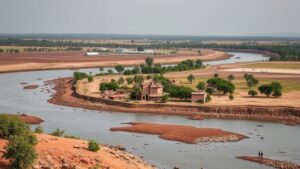Documenting the majestic spires of Ha Long Bay in Vietnam.
Documenting the Majestic Spires of Ha Long Bay in Vietnam
Ha Long Bay, located in the northern part of Vietnam, is renowned for its breathtaking collection of limestone karsts and spires. This UNESCO World Heritage Site, spanning approximately 1,553 square kilometers and featuring around 1,600 islands and islets, has captivated adventurers, nature lovers, and photographers alike. The regions unique geological formations, history, and biodiversity offer an endless source of inspiration for those seeking to document its beauty.
The Geological Formation of Ha Long Bay
The stunning limestone karsts of Ha Long Bay were formed over millions of years through a combination of tectonic activity and erosion. About 500 million years ago, the area was submerged under seawater, allowing geological processes to sculpt the majestic spires we see today. The karsts, characterized by their towering heights and steep cliffs, can reach elevations of up to 200 meters and are often surrounded by tranquil emerald waters.
To grasp the significance of this phenomenon, consider that similar limestone formations are found globally, yet Ha Long Bay remains unique due to its sheer scale and density. The regions formations provide a vital habitat for a diverse range of flora and fauna, making it an ecological treasure.
Beyond its natural allure, Ha Long Bay holds profound cultural importance. bay is associated with local legends and folklore, most notably the story of a dragon. According to local mythology, a dragon descended from the sky and forged the islands with its tail to protect the Vietnamese people from invaders. This tale contributes to the bays identity and encourages the preservation of its natural wonders.
During the 20th century, Ha Long Bay has also served as a backdrop for pivotal historical events. area was a focal point during the Vietnam War and has influenced local culture, art, and literature. Today, both locals and tourists endeavor to document this rich history alongside the areas natural beauty.
Notable Locations to Document
When exploring and documenting Ha Long Bay, several locations stand out for their stunning landscapes and rich history:
- Ti Top Island: Known for its sandy beaches and panoramic views from the summit, Ti Top Island is a popular spot for photographers aiming to capture the sun setting over the bay.
- Cat Ba Island: Home to Cat Ba National Park, this island offers a stark contrast to the karsts with its lush greenery and wildlife, ideal for nature documentaries.
- Sung Sot Cave: This large cave system features impressive stalagmites and stalactites, providing unique photographic opportunities as light filters through openings.
- Dau Go Island: Famed for its historical significance, this site houses ancient artifacts and boasts another stunning cave system.
Conservation Efforts and Challenges
Despite its beauty, Ha Long Bay faces several environmental challenges, including pollution and over-tourism. The Vietnamese government has implemented various conservation measures, including strict regulations on fishing activities and tourism practices. e initiatives aim to protect the fragile ecosystem while allowing visitors to experience the bays majesty.
In recent years, ecotourism has gained popularity, promoting responsible tourism practices that can positively contribute to conservation efforts. Educating tourists about the bays ecological importance can also create a more sustainable travel culture.
Real-World Applications: Documenting Ha Long Bay
For photographers, travel writers, and conservationists, documenting the spires of Ha Long Bay presents numerous opportunities. Here are actionable takeaways for those wishing to capture the essence of this remarkable site:
- Use high-quality photography equipment to capture the natural beauty of the spires, especially during the golden hours of sunrise and sunset.
- Engage with local guides who can provide insights into the regions culture and history, enriching the storytelling aspect of documentation.
- Attend local festivals to showcase the bays cultural significance, providing a deeper context to photographs and articles.
- Support local conservation programs by promoting sustainable tourism practices and participating in cleanup initiatives.
Conclusion
Ha Long Bay, with its majestic spires, rich history, and ecological diversity, offers an unparalleled canvas for documentation. By capturing its beauty responsibly, we not only preserve its legacy for future generations but also promote awareness of its environmental significance. As visitors explore this wonder, they are encouraged to leave a positive impact, ensuring that these incredible natural formations continue to inspire awe for years to come.



